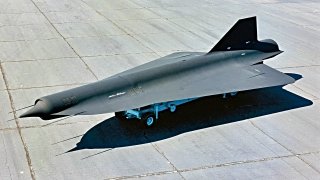D-21: America's Mach 3 Drone Used to Spy on China's Nuclear Weapons
The D-21 was America’s first foray into drone technology, developed by Lockheed Martin's Skunk Works in the 1960s in response to growing Soviet anti-aircraft defenses.
Summary and Key Points: The D-21 was America’s first foray into drone technology, developed by Lockheed Martin's Skunk Works in the 1960s in response to growing Soviet anti-aircraft defenses.
-This supersonic surveillance drone, capable of flying at Mach 3.2, was initially launched from the SR-71 Blackbird before transitioning to the B-52H bomber.
-The D-21's primary mission was to gather intelligence on China’s nuclear program, but the project ultimately failed, with all four missions (1969-71) unsuccessful.
-Despite this, the D-21 significantly influenced future U.S. drone technology, and China's later WZ-8 drone bore a strong resemblance to the D-21.
The D-21 was America’s First Attempt at Drones
When one thinks of unmanned aerial vehicles, or drones, the MQ-1 Predator or the MQ-9 Reaper probably come to mind.
But America’s drones have a much longer operational history.
Way back in the 1960s, Lockheed Martin designed the D-21 supersonic surveillance drone at their Skunk Works facility. Created in response to the downing of Gary Powers and his U-2 spy plane, the D-21 was the U.S. military and intelligence community’s solution to the rapidly advancing Soviet anti-aircraft defenses ringing the Communist bloc states.
The D-21 Specs
Designed to fly at an astonishing Mach 3.2, or 2,455 miles per hour, the D-21 employed a ramjet engine. This insanely fast early drone would be launched from an SR-71 Blackbird and continue to its target at supersonic speeds.
If it were shot down, no one would be lost, and the Americans would have a degree of deniability.
Because of the D-21’s unique design, though, launching from an equally radical airframe such as the SR-71 Blackbird proved to be a problem. So the Pentagon switched to a B-52H bomber. A rocket booster would launch the drone from the wing of the Stratofortress.
China’s Nuclear Weapons Program
When the D-21 went active, the People’s Republic of China was rapidly developing an illicit nuclear weapons program. At this time, China was very similar to how we might today view North Korea: It was a backward and isolated land ruled by a vicious cult of personality.
But China wanted nukes, and the Americans were rightly concerned about this prospect, especially given China’s close alliance at that time with the Soviet Union.
China’s main nuclear test site was at a place called Lop Nur. To get a better read on what was occurring there, the Americans deployed their D-21 surveillance drone. Four major intelligence collection missions were launched against this target over the course of two years (1969-71).
A Failure?
The program failed. According to Maya Carlin, two of the four drones were lost somewhere over China, while the other two malfunctioned and delivered no usable intelligence.
The Pentagon canceled the program in 1971. Unsurprisingly, the Chinese down the line unveiled their own supersonic drone, the WZ-8, which looked suspiciously like the D-21.
The Chinese had captured one or both of the D-21s that were lost over the Middle Kingdom and reverse-engineered them. This, of course, was a portent of things to come.
Lockheed Martin’s design for the D-21 would go on to significantly influence future drone technology for the U.S. military. Even modern drones have been inspired by the lessons learned from the D-21. While the missions technically ended in failure, the program was not a complete waste of time.
Author Experience and Expertise: Brandon J. Weichert
Brandon J. Weichert, a National Interest national security analyst, is a former Congressional staffer and geopolitical analyst who is a contributor at The Washington Times, the Asia Times, and The-Pipeline. He is the author of Winning Space: How America Remains a Superpower, Biohacked: China’s Race to Control Life, and The Shadow War: Iran’s Quest for Supremacy. His next book, A Disaster of Our Own Making: How the West Lost Ukraine, is due October 22 from Encounter Books. Weichert can be followed via Twitter @WeTheBrandon.
All images are Creative Commons or Shutterstock.
From the Vault
Russia Freaked Out: Why the U.S. Navy 'Unretired' the Iowa-Class Battleships
Battleship vs. Battlecruiser: Iowa-Class vs. Russia's Kirov-Class (Who Wins?)


